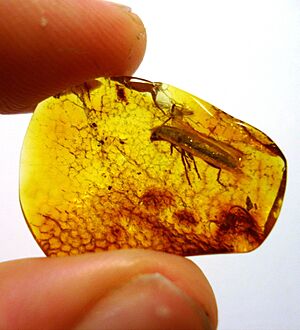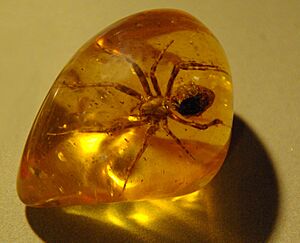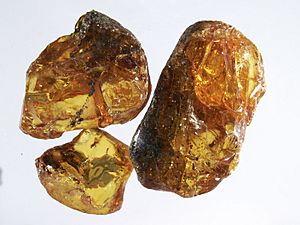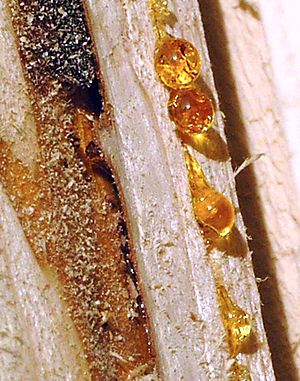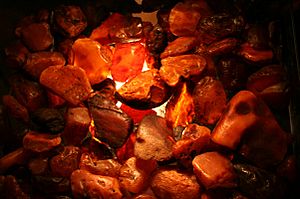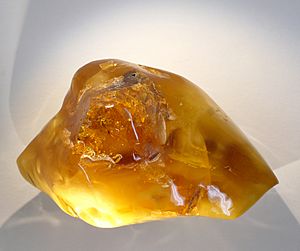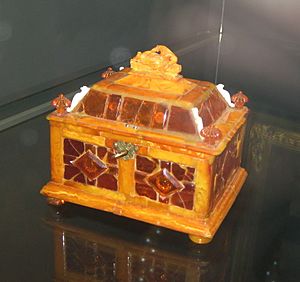Amber facts for kids
Amber is the common name for fossil resin. It's like a natural time capsule! This beautiful material comes in many colors and has been prized as a gemstone for thousands of years. People use amber to make all sorts of decorative items, especially jewelry. It was also used in traditional medicine in the past.
Most amber found today is very old, usually between 30 to 90 million years old. Sometimes, resin that hasn't fully fossilized is called copal. Ancient people had special names for amber. The Norse people called Baltic amber 'Freya's tears,' and the ancient Greeks called it the 'tears of the Heliades.'
Amber is made of different parts of tree resin. Some parts can dissolve in certain liquids, while others cannot. Scientists classify amber into different types based on its chemical makeup. Since amber starts as soft, sticky tree sap, it often traps small animals and plants inside. These trapped items are called inclusions.
Contents
The Story of Amber
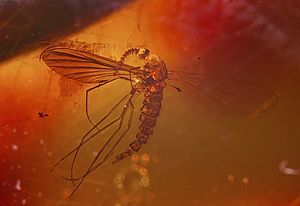
The word "amber" comes from the Arabic word for it. In Persian, true amber was called kahroba, which means "that which attracts straw." This name came from amber's ability to get an electric charge when rubbed, which makes it attract light things like straw.
Many famous ancient writers, like Homer, Aristotle, and Plato, wrote about amber. The Roman historian Tacitus mentioned the Aesti people, who were known for collecting amber from the Baltic Sea.
Evidence suggests that during the Nordic Bronze Age, the Baltic Sea coasts were the main source of amber for much of Europe. For example, amber jewelry found in ancient Mycenaean graves in Greece has been traced back to the Baltic Sea.
In the 14th century, the Teutonic Knights controlled amber production in Europe. They made it illegal to collect amber from beaches they controlled, and breaking this rule could even lead to death.
How Amber Forms
Amber forms from the sticky sap that comes out of certain trees. This sap soon hardens into a gum and, over millions of years, turns into fossilized amber. The way amber looks can depend on the type of tree it came from and its journey through geological time.
For resin to become amber, it must survive decay. Many trees produce resin, but usually, it breaks down due to weather, bacteria, and fungi. To last long enough to become amber, the resin needs to be very strong or be produced in conditions that protect it from these forces.
Baltic amber, also known as Prussian amber, is found as chunks in a marine sand called blue earth. This sand is part of the Lower Oligocene rock layers in Sambia, Kaliningrad Oblast, Russia. Today, it is systematically mined there.
Some amber, like Agathis amber, comes from the Agathis conifer tree. This tree used to grow in many more places than it does now. Amber found in America and Africa often comes from the Hymenaea tree, which is a type of flowering plant.
Trapped in Time: Amber Inclusions
Because tree resin is so sticky, it often traps small organisms. These can include insects, spiders, worms, frogs, and other tiny creatures. When the resin hardens and becomes amber, these creatures are preserved inside. Sometimes, only a hollow space is left, but often, parts of the organism, like the hard outer shell of an insect, remain. These trapped items are called inclusions and give scientists a peek into ancient life.
Where Amber is Found and Used
Amber is found along the shores of the Baltic Sea and the North Sea. The biggest source of amber in the world is the Sambia peninsula, which is now part of Russia's Kaliningrad Oblast. About 90% of the world's usable amber comes from this region on the Baltic Sea.
This amber was formed in the late Eocene and early Oligocene periods. It was deposited in a river delta in a shallow part of a prehistoric ocean. Besides the coast near Kaliningrad, amber is also found in other parts of the Baltic Sea region.
Small amounts of Baltic amber can even be found outside the Baltic region, such as on the coastline of southeastern England.
Amber is widely used for making beads, other ornaments, and parts of smoking pipes. A famous example is the Amber Room in the Catherine Palace near Saint Petersburg, Russia. This room is a stunning reproduction of the original, which was destroyed during World War II.
People have used amber for jewelry since the Stone Age, as far back as 13,000 years ago. Amber ornaments have been discovered in ancient Mycenaean tombs and other places across Europe. Today, it's still used for jewelry and even in glassblowing tools. Amber's cultural importance also makes it a tourist attraction, with places like the Palanga Amber Museum dedicated to this fossilized resin.
Amber has also been used in traditional medicine for its believed healing powers. From the time of Hippocrates in ancient Greece through the Middle Ages and into the early 20th century, amber and its extracts were used for many different treatments. In ancient China, it was customary to burn amber during big celebrations.
Images for kids
-
Solutrean amber from Altamira in the Muséum de Toulouse
-
Pendants made of amber. The oval pendant is 52 by 32 mm (2 by 1+1⁄4 in).
Related pages
See also
 In Spanish: Ámbar para niños
In Spanish: Ámbar para niños


